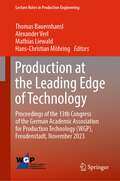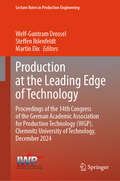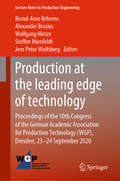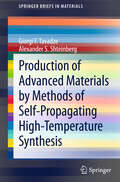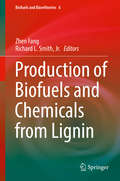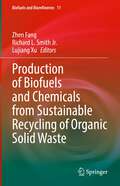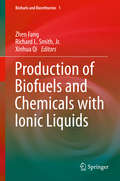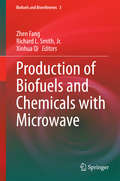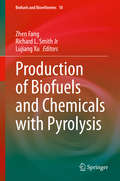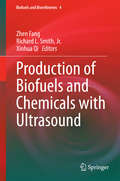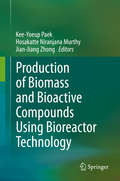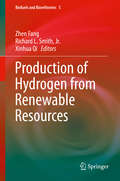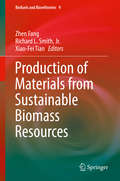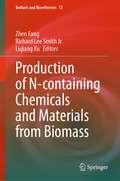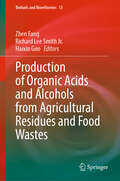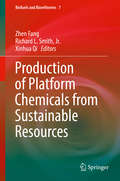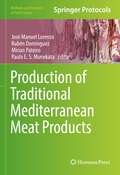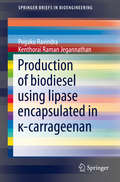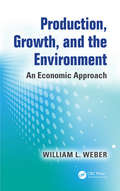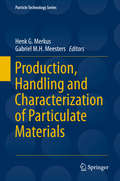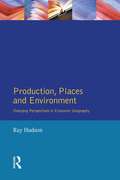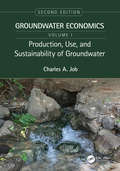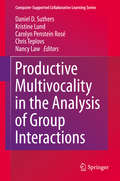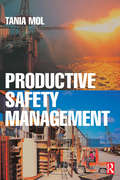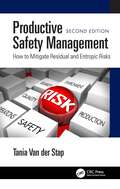- Table View
- List View
Production at the Leading Edge of Technology: Proceedings of the 13th Congress of the German Academic Association for Production Technology (WGP), Freudenstadt, November 2023 (Lecture Notes in Production Engineering)
by Thomas Bauernhansl Alexander Verl Mathias Liewald Hans-Christian MöhringThe German Academic Association for Production Technology (WGP) annually invites researchers coming from its institutes and from industry to contribute peer reviewed papers in the field of production technology. This congress proceedings provides recent research results and findings on leading-edge manufacturing processes. Main aim of this scientific congress is to push forward existing borders in production and to provide novel solutions of "Production at the Leading Edge of Manufacturing Technology.The subtitle “Technology-Based Sustainable Production for Circular Economy” of this year’s congress emphasizes challenges for global productions in the light of climate change and resource scarcity. Different sessions were held on the topicsEnvironmentally neutral production (e.g. energy and material efficiency)Resilient Value Creation SystemsBiointelligenceDigitization as an Enabler for Sustainable ProductionProduction Technologies for a Circular Economy
Production at the Leading Edge of Technology: Proceedings of the 14th Congress of the German Academic Association for Production Technology (WGP), Chemnitz University of Technology, December 2024 (Lecture Notes in Production Engineering)
by Steffen Ihlenfeldt Welf-Guntram Drossel Martin DixThis book contains all contributions to the congress, in which both detailed scientific investigations and technological innovations in the process chains of machining and forming are discussed as well as comprehensive, far-sighted overall views on the planning and control of production processes. These approaches are supplemented by more interdisciplinary cross-sectional topics such as robotics, control engineering, automation, materials technology, additive manufacturing and human-centered production. It is particularly striking that the main approaches presented aim to improve efficiency in production using data-driven methods such as machine learning and artificial intelligence. However, the use of measurement results to improve simulations is also frequently addressed. The book proceedings show that transformations can only succeed through the realization of both detailed technical improvements in production technologies and optimized production organization.
Production at the leading edge of technology: Proceedings of the 10th Congress of the German Academic Association for Production Technology (WGP), Dresden, 23-24 September 2020 (Lecture Notes in Production Engineering)
by Alexander Brosius Bernd-Arno Behrens Wolfgang Hintze Steffen Ihlenfeldt Jens Jens WulfsbergThis congress proceedings provides recent research on leading-edge manufacturing processes. The aim of this scientific congress is to work out diverse individual solutions of "production in the border area" and transferable methodological approaches. In addition, guest speakers with different backgrounds will give the congress participants food for thoughts, interpretations, views and suggestions.The manufacturing industry is currently undergoing a profound structural change, which on the one hand produces innovative solutions through the use of high-performance communication and information technology, and on the other hand is driven by new requirements for goods, especially in the mobility and energy sector. With the social discourse on how we should live and act primarily according to guidelines of sustainability, structural change is gaining increasing dynamic.It is essential to translate politically specified sustainability goals into socially accepted and marketable technical solutions. Production research is meeting this challenge and will make important contributions and provide innovative solutions from different perspectives.
Production of Advanced Materials by Methods of Self-Propagating High-Temperature Synthesis
by Alexander Shteinberg Giorgi F TavadzeThis translation from the original Russian book outlines the production of a variety of materials by methods of self-propagating high-temperature synthesis (SHS). The types of materials discussed include: hard, refractory, corrosion and wear-resistant materials, as well as other advanced and specialty materials. The authors address the issue of optimal parameters for SHS reactions occurring during processes involving a preliminary metallothermic reduction stage, and they calculate these using thermodynamic approaches. In order to confirm the effectiveness of this approach, the authors describe experiments focusing on the synthesis of elemental crystalline boron, boron carbides and nitrides. Other parts of this brief include theoretical and experimental results on single-stage production of hard alloys on the basis of titanium and zirconium borides, as well as macro kinetics of degassing and compaction of SHS-products. This brief is suitable for academics, as well as those working in industrial manufacturing companies producing hard alloys and composites for making metal-working machinery or drilling equipment.
Production of Biofuels and Chemicals from Lignin
by Richard L. Smith Jr. Zhen FangThis book provides state-of-the-art reviews, current research on and the prospects of lignin production, biological, thermal and chemical conversion methods, and lignin technoeconomics. Fundamental topics related to lignin chemistry, properties, analysis, characterization, and depolymerization mechanisms, as well as enzymatic, fungal and bacterial degradation methods are covered. The book also examines practical topics related to technologies for lignin and ultra-pure lignin recovery, activated carbon, carbon fiber production and materials, and addresses the biological conversion of lignin with fungi, bacteria or enzymes to produce chemicals, along with chemical, catalytic, thermochemical and solvolysis conversion methods. Lastly, it presents a case study on practical polyurethane foam production using lignin. Lignin has a bright future and will be an essential feedstock for producing renewable chemicals, biofuels and value-added products. Offering comprehensive information on this promising material, the book represents a valuable resource for students, researchers, academicians and industrialists in the field of biochemistry and energy.
Production of Biofuels and Chemicals from Sustainable Recycling of Organic Solid Waste (Biofuels and Biorefineries #11)
by Richard L. Smith Zhen Fang Lujiang XuThis book covers sustainable recycling processes (e.g. physical, biological, chemical, and thermo-chemical) of multiple organic solid wastes, provides methods for material recycle of wastes into value-added products including fuels and commodity chemicals that are able to be directly applied to promote manufacturing processes. Aimed at improving the awareness of effective conversion protocols and for developing innovative biomass conversion processes, this text was conceived as a collection of studies on state-of-art techniques and know-how for production of biofuels and chemicals from sustainable recycling of organic solid wastes. Topics in the text are discussed in terms of addressing recent advances, assessing and highlighting promising new methods or new technological strategies and direct conversion of organic solid wastes to process feeds. Highly-recognized authorities, experts and professionals have contributed individual chapters in selected areas to cover the overall topic in a comprehensive manner.
Production of Biofuels and Chemicals with Ionic Liquids
by Richard L. Smith Zhen Fang Xinhua QiThe application of ionic liquids to biomass for producing biofuels and chemicals will be one of the hot research areas during the next decade due to the fascinating properties of these versatile group of solvents that allow them to dissolve lignocellulosic materials. The present text provides up-to-date fundamentals, state-of-the-art reviews, current assessments and prospects in this area, including aspects of pretreatment, fermentation, biomass dissolution, cellulose transformation, reaction kinetics and physical properties, as well as the subsequent production of biofuels and platform chemicals such as sugars, aldehydes and acids. Auxiliary methods such as catalysis, microwave and enzymatic techniques used in the transformations are covered. Both researchers and practitioners are certain to find a wealth of information in the individual chapters, which were written by experts in the field to provide an essential basis for assessing possible pretreatment and transformation routes of biomass using ionic liquids, and for developing new methods and chemical processes. Dr. Zhen Fang is Professor of Bioenergy, head of the Chinese Academy of Sciences' Biomass Group, Xishuangbanna Tropical Botanical Garden and is also an Adjunct Professor of Life Sciences, University of Science and Technology of China. Dr. Richard L Smith, Jr. is Professor of Chemical Engineering at the Graduate School of Environmental Studies, Research Center of Supercritical Fluid Technology, Tohoku University, Japan. Dr. Xinhua Qi is Professor of Environmental Science at Nankai University, China.
Production of Biofuels and Chemicals with Microwave
by Richard L. Smith Jr. Zhen Fang Xinhua QiConversion of biomass into chemicals and biofuels is an active research and development area as trends move to replace traditional fossil fuels with renewable resources. By integrating processing methods with microwave and ultrasound irradiation into biorefineries, the time-scale of many operations can be greatly reduced while the efficiency of the reactions can be remarkably increased so that process intensification can be achieved. "Production of Biofuels and Chemicals with Microwave" and "Production of Biofuels and Chemicals with Ultrasound" are two independent volumes in the Biofuels and Biorefineries series that take different, but complementary approaches for the pretreatment and chemical transformation of biomass into chemicals and biofuels. The volume "Microwave" provides current research advances and prospects in theoretical and practical aspects of microwave irradiation including properties, effects and temperature monitoring, design of chemical reactors, synergistic effects on combining microwave, ultrasound, hydrodynamic cavitation and high-shear mixing into processes, chemical and catalytic conversion of lignin into chemicals, pyrolysis and gasification, syngas production from wastes, platform chemicals, algal biodiesel, cellulose-based nanocomposites, lignocellulosic biomass pretreatment, green chemistry metrics and energy consumption and techno-economic analysis for a catalytic pyrolysis facility that processes pellets into aromatics. Each of the 12 chapters has been peer-reviewed and edited to improve both the quality of the text and the scope and coverage of the topics. Both volumes "Microwave" and "Ultrasound" are references designed for students, researchers, academicians and industrialists in the fields of chemistry and chemical engineering and include introductory chapters to highlight present concepts of the fundamental technologies and their application. Dr. Zhen Fang is Professor in Bioenergy, Leader and founder of biomass group, Chinese Academy of Sciences, Xishuangbanna Tropical Botanical Garden and is also adjunct Professor of Life Sciences, University of Science and Technology of China. Dr. Richard L Smith, Jr. is Professor of Chemical Engineering, Graduate School of Environmental Studies, Research Center of Supercritical Fluid Technology, Tohoku University, Japan. Dr. Xinhua Qi is Professor of Environmental Science, Nankai University, China.
Production of Biofuels and Chemicals with Pyrolysis (Biofuels and Biorefineries #10)
by Richard L. Smith Zhen Fang Lujiang XuThis book presents a collection of studies on state-of-art techniques for converting biomass to chemical products by means of pyrolysis, which are widely applicable to the valorization of biomass. In addition to discussing the fundamentals and mechanisms for producing bio-oils, chemicals, gases and biochar using pyrolysis, it outlines key reaction parameters and reactor configurations for various types of biomass. Written by leading experts and providing a broad range of perspectives on cutting-edge applications, the book is a comprehensive reference guide for academic researchers and industrial engineers in the fields of natural renewable materials, biorefinery of lignocellulose, biofuels, and environmental engineering, and a valuable resource for university students in the fields of chemical engineering, material science and environmental engineering.
Production of Biofuels and Chemicals with Ultrasound
by Richard L. Smith Zhen Fang Xinhua QiConversion of biomass into chemicals and biofuels is an active research and development area as trends move to replace traditional fossil fuels with renewable resources. By integrating processing methods with ultrasound and microwave irradiation into biorefineries, the time-scale of many operations can be greatly reduced while the efficiency of the reactions can be remarkably increased so that process intensification can be achieved. "Production of Biofuels and Chemicals with Ultrasound" and "Production of Biofuels and Chemicals with Microwave" are two independent volumes in the Biofuels and Biorefineries series that take different, but complementary approaches for the pretreatment and chemical transformation of biomass into chemicals and biofuels. The volume "Ultrasound" provides current research advances and prospects in mechanistic principles of acoustic cavitation in sonochemistry, physical and chemical mechanisms in biofuel synthesis, reactor design for transesterification and esterification reactions, lipid extraction from algal biomass, microalgae extraction, biodiesel and bioethanol synthesis, practical technologies and systems, pretreatment of biomass waste sources including lignocellulosic materials, manures and sludges for biogas production, vibration-assisted pelleting, combined chemical-mechanical methods, valorization of starch-based wastes and techno-economic methodology. Each of the 12 chapters has been peer-reviewed and edited to improve both the quality of the text and the scope and coverage of the topics. Both volumes "Ultrasound" and "Microwave" are references designed for students, researchers, academicians and industrialists in the fields of chemistry and chemical engineering and include introductory chapters to highlight present concepts of the fundamental technologies and their application. Dr. Zhen Fang is Professor in Bioenergy, Leader and founder of biomass group, Chinese Academy of Sciences, Xishuangbanna Tropical Botanical Garden and is also adjunct Professor of Life Sciences, University of Science and Technology of China. Dr. Richard L Smith, Jr. is Professor of Chemical Engineering, Graduate School of Environmental Studies, Research Center of Supercritical Fluid Technology, Tohoku University, Japan. Dr. Xinhua Qi is Professor of Environmental Science, Nankai University, China.
Production of Biomass and Bioactive Compounds Using Bioreactor Technology
by Jian-Jiang Zhong Kee-Yoeup Paek Hosakatte Niranjana MurthyThe bioactive compounds of plants have world-wide applications in pharmaceutical, nutraceutical and food industry with a huge market. In this book, a group of active researchers have addressed on the most recent advances in plant cell and organ cultures for the production of biomass and bioactive compounds using bioreactors. Tremendous efforts have been made to commercialize the production of plant metabolites by employing plant cell and organ cultures in bioreactors. This book emphasizes on the fundamental topics like designing of bioreactors for plant cell and organ cultures, various types of bioreactors including stirred tank, airlift, photo-bioreactor, disposable bioreactor used for plant cell and organ cultures and the advantages and disadvantages of bioreactor cultures. Various strategies for biomass production and metabolite accumulation have been discussed in different plant systems including Korean/Chinese ginseng, Siberian ginseng, Indian ginseng, Echinacea, St. John's wort, Noni, Chinese licorice, Caterpillar fungus and microalgae. Researches on the industrial application of plant cells and organs with future prospects as well as the biosafety of biomass produced in bioreactors are also described. The topics covered in this book, such as plant cell and organ cultures, hairy roots, bioreactors, bioprocess techniques, will be a valuable reference for plant biotechnologists, plant biologists, pharmacologists, pharmacists, food technologists, nutritionists, research investigators of healthcare industry, academia, faculty and students of biology and biomedical sciences. The multiple examples of large-scale applications of cell and organ cultures will be useful and significant to industrial transformation and real commercialization.
Production of Hydrogen from Renewable Resources
by Richard L. Smith Zhen Fang Xinhua QiThis book provides state-of-the-art reviews, current research and prospects of producing hydrogen using bio, thermal and electrochemical methods and covers hydrogen separation, storage and applications. Hydrogen produced from biomass offers a clean and renewable energy source and a promising energy carrier that will supplement or replace fossil fuels in the future. The book is intended as a reference work for researchers, academics and industrialists working in the chemical and biological sciences, engineering, renewable resources and sustainability. Readers will find a wealth of information in the text that is both useful for the practical development of hydrogen systems and essential for assessing hydrogen production by bioelectrochemical, electrochemical, fermentation, gasification, pyrolysis and solar means, applied to many forms of biomass. Dr. Zhen Fang is Professor in Bioenergy, Leader and founder of biomass group, Chinese Academy of Sciences, Xishuangbanna Tropical Botanical Garden and is also adjunct Professor of Life Sciences, University of Science and Technology of China. Dr. Richard L Smith, Jr. is Professor of Chemical Engineering, Graduate School of Environmental Studies, Research Center of Supercritical Fluid Technology, Tohoku University, Japan. Dr. Xinhua Qi is Professor of Environmental Science, Nankai University, China.
Production of Materials from Sustainable Biomass Resources (Biofuels and Biorefineries #9)
by Zhen Fang Richard L. Smith Jr Xiao-Fei TianThis book presents a collection of studies on state-of-art techniques developed specifically for lignocellulose component derivation, and for the production of functional materials, composite polymers, carbonaceous biocatalysts, and pellets from lignocellulosic biomass, with an emphasis on using sustainable chemistry and engineering to develop innovative materials and fuels for practical application. Technological strategies for the physical processing or biological conversion of biomass for material production are also presented. All chapters were contributed by respected experts in the field from around the globe, providing a broad range of perspectives on cutting-edge applications.The book offers an ideal reference guide for academic researchers and industrial engineers in the fields of natural renewable materials, biorefinery of lignocellulose, biofuels and environmental engineering. It can also be used as a comprehensive reference source for university students in chemical engineering, material science and environmental engineering.
Production of N-containing Chemicals and Materials from Biomass (Biofuels and Biorefineries #12)
by Zhen Fang Lujiang Xu Richard Lee Smith JrThis book is a collection of studies on state-of-art techniques developed for producing value-added N-containing chemicals and N-doped carbon materials from renewable sources via sustainable technologies. Aiming to improve conversion effectiveness and develop innovative techniques for new value-added N-containing products, topics in the text address recent advances, assess and highlight promising methods or technological strategies, and outline direct conversion routes for conversion of renewable resources to N-containing chemicals and materials. World-renowned authorities, experts, and professionals have contributed individual chapters in selected areas to cover the overall topic comprehensively. In addition to researchers and professionals in the field, educators teaching university courses on biomass transformation, biomass energy, energy materials, heterocyclic chemistry, resource materials and sustainable development and green chemistry will find the text informative with new international perspectives.
Production of Organic Acids and Alcohols from Agricultural Residues and Food Wastes (Biofuels and Biorefineries #13)
by Zhen Fang Richard Lee Smith Jr. Haixin GuoThis book is a collection of studies on recent technological developments and related challenges in laboratory and industrial applications and processes for the production of biomass-derived organic acids and alcohols. By exploring topics in catalysis, hydrothermal processes, fermentation, and anaerobic digestion, this volume offers a comprehensive overview of how biomass-derived compounds can be transformed into organic acids and essential chemicals. Focusing on laboratory and industrial applications, it highlights advantages and limitations of established methods while presenting innovative techniques for producing biomass-derived organic acids and alcohols. This book provides diverse examples of applications in producing biomass-derived organic acids, alcohols, and biogas, such as polymer enhancement additives, food waste amino acid recovery, and effective use of wastes for nutrient recycling. The scope of the text encompasses lignocellulosic biomass, agricultural residues, food wastes, biomass-derived compounds, and fundamental carbohydrates to develop overall production strategies for organic acids and alcohols. This book is tailored for professionals in academia and industry working with natural renewable materials, platform chemicals, polymers, and materials science. It also serves as a valuable reference for university students studying chemical engineering or environmental sciences. It offers critical insights into sustainable chemical production practices that are crucial for advancing renewable energy solutions.
Production of Platform Chemicals from Sustainable Resources
by Richard L. Smith Jr. Zhen Fang Xinhua QiThis book provides state-of-the-art reviews, the latest research, prospects and challenges of the production of platform chemicals such as C6 sugars, 5-hydroxymethylfurfural, furfural, gamma-valerolactone, xylitol, 2,5-furandicarboxylic acid, levulinic acid, ethanol and others from sustainable biomass resources using processes that include heterogeneous catalysis, ionic liquids, hydrothermal/solvothermal, electrochemical and fermentation methods. It also discusses the application of these chemicals and their derivatives for synthesizing commodity chemicals via various routes. Intended as a reference resource for researchers, academicians and industrialists in the area of energy, chemical engineering and biomass conversion, it provides a wealth of information essential for assessing the production and application of various biomass-derived platform chemicals using biological, chemical and electrochemical techniques.
Production of Traditional Mediterranean Meat Products (Methods and Protocols in Food Science)
by José Manuel Lorenzo Paulo E. S. Munekata Rubén Domínguez Mirian PateiroThis volume details the inventory and characterizes traditional meat products within each geographic region. Consisting of 21 chapters, chapters guide readers through comprehensive descriptions of the materials and processing conditions used to make each meat product so that it can be manufactured by other researchers or industries. In addition, each book chapter includes explanatory notes and elucidate the possible specific points to take into account for the correct manufacture. Authoritative and cutting-edge, Production of Traditional Mediterranean Meat Products aims to standardize the manufacturing process of the main Mediterranean traditional meat products, since there are several variations between manufacturers or regions.
Production of biodiesel using lipase encapsulated in κ-carrageenan
by Pogaku Ravindra Kenthorai Raman JegannathanThis book explores a novel technique for processing biodiesel using lipase immobilization by encapsulation and its physical properties, stability characteristics, and application in stirred tank and re-circulated packed bed immobilized reactors for biodiesel production. The enzymatic processing of biodiesel addresses many of the problems associated with chemical processing. It requires only moderate operating conditions and yields a high-quality product with a high level of conversion and the life cycle assessment of enzymatic biodiesel production has more favourable environmental consequences. The chemical processing problems of waste water treatment are lessened and soap formation is not an issue, meaning that waste oil with higher FFA can be used as the feedstock. The by product glycerol does not require any purification and it can be sold at higher price. However, soluble enzymatic processing is not perfect. It is costly, the enzyme cannot be recycled and its removal from the product is difficult. For these reasons, immobilized enzymatic process has been developed which retains the advantages of the soluble enzymatic process and reuse of the enzyme is possible which decreases the enzyme cost, the biodiesel produced does not contain any enzyme residue and the activity of the enzyme can be increased by immobilization. The drawbacks of the immobilized enzyme process are mass transfer limitation, enzyme leakage, the lack of a versatile commercial immobilized enzyme and some of immobilization methods involve toxic chemicals. To overcome the drawbacks of the immobilized enzyme, an attempt is made to use a degradable biopolymer (κ-carrageenan) as a carrier for lipase immobilization.
Production, Growth, and the Environment: An Economic Approach
by William L. WeberWritten in a way that facilitates understanding of complex concepts, laws, and policy, Production, Growth, and the Environment: An Economic Approach explores how economic growth usually makes people better off, but also asks at what environmental cost? These costs are not often realized until after the fact, when their remediation is more expensive
Production, Handling and Characterization of Particulate Materials
by Henk G. Merkus Gabriel M. H. MeestersThis edited volume presents most techniques and methods that have been developed by material scientists, chemists, chemical engineers and physicists for the commercial production of particulate materials, ranging from the millimeter to the nanometer scale. The scope includes the physical and chemical background, experimental optimization of equipment and procedures, as well as an outlook on future methods. The books addresses issues of industrial importance such as specifications, control parameter(s), control strategy, process models, energy consumption and discusses the various techniques in relation to potential applications. In addition to the production processes, all major unit operations and characterization methods are described in this book. It differs from other books which are devoted to a single technique or a single material. Contributors to this book are acknowledged experts in their field. The aim of the book is to facilitate comparison of the different unit operations leading to optimum equipment choices for the production, handling and storage of particulate materials. An advantage of this approach is that unit operations that are common in one field of application are made accessible to other fields. The overall focus is on industrial application and the book includes some concrete examples. The book is an essential resource for students or researchers who work in collaboration with manufacturing industries or who are planning to make the switch from academia to industry.
Production, Places and Environment
by Ray HudsonDrawing upon 25 years of original research, Production, Places and Environment provides a unique combination of rich, varied and theoretically informed case studies, along with more general analyses of processes and changing theoretical and methodological perspectives in economic geography that are informed by original empirical research.Through a huge range of his own groundbreaking case material the author explores such essential factors as space, production, social and political concerns, and environmental issues, being careful to ground the more complex theory in the more general tendencies in economic geography and the social sciences.
Production, Use, and Sustainability of Groundwater: Groundwater Economics, Volume 1
by Charles A. JobGroundwater is becoming increasingly scarce while the demand for water continues to grow at a global scale. Understanding groundwater resources and their sustainable management is imperative for the future of groundwater use, conservation and protection. This revised and updated two-volume set, focused on sustainability, covers the economic values of groundwater production and use, including micro- and macroeconomic factors, groundwater markets, economic evaluation tools, climate change, transboundary issues and policy evaluation. It explores numerous applications and describes ways to evaluate the economics of groundwater use in the context of the larger ecosystem and the natural capital it provides. FEATURES OF THIS VOLUME Includes an important new chapter on groundwater sustainability management Addresses new examples of groundwater use that are applicable at both the local and international levels Provides the foundation for policy, program and project analysis for all major uses of groundwater Updates groundwater use data along with explanations of major production costs and use benefits Gives a new perspective on users’ competition for the subsurface environment Production, Use, and Sustainability of Groundwater, Second Edition, the first volume of the two-volume set Groundwater Economics, is a must-have for any professional or student who needs to understand, evaluate and manage water resources from a range of production and use perspectives affecting groundwater resource sustainability.
Productive Multivocality in the Analysis of Group Interactions
by Nancy Law Kristine Lund Daniel D. Suthers Carolyn Penstein Rosé Chris TeplovsThe key idea of the book is that scientific and practical advances can be obtained if researchers working in traditions that have been assumed to be mutually incompatible make a real effort to engage in dialogue with each other, comparing and contrasting their understandings of a given phenomenon and how these different understandings can either complement or mutually elaborate on each other. This key idea applies to many fields, particularly in the social and behavioral sciences, as well as education and computer science. The book shows how we have achieved this by presenting our study of collaborative learning during the course of a four-year project. Through a series of five workshops involving dozens of researchers, the 37 editors and authors involved in this project studied and reported on collaborative learning, technology enhanced learning, and cooperative work. The authors share an interest in understanding group interactions, but approach this topic from a variety of traditional disciplinary homes and theoretical and methodological traditions. This allows the book to be of use to researchers in many different fields and with many different goals and agendas.
Productive Safety Management: A Strategic, Multi-disciplinary Management System For Hazardous Industries That Ties Safety And Production Together
by Tania MolUnlike most books on this subject, Productive Safety Management, described in this book, integrates occupational health and safety, human resource management, environmental management, and engineering to provide a whole-business approach to effective safety management.The book helps companies to reduce and manage risk by providing, analysing and improving systems in place within the company. It also looks at how external factors can affect company decision making and provides a tool to make sure that a health and safety management system is strategically aligned, appropriately resourced, and that it maximises employee commitment. Chapters on human resource management explore cultural issues and explain how to gain commitment to company objectives.The book has been written for managers and supervisors working in hazardous industries, OHS practitioners, undergraduate and postgraduate students.
Productive Safety Management: How to Mitigate Residual and Entropic Risks, Second Edition
by Tania Van der StapThis book discusses the realm of operational risk management, exploring the intricacies of managing safety, production and quality simultaneously. It offers a fresh perspective on the dynamic and complex nature of risk, highlighting the ever‑changing landscape that organisations must navigate. The reliance on current understandings of residual risk is deficient, particularly as systems of production are prone to degradation over time. This degradation leads to an increase in ‘entropic risk’, resulting in losses in daily production that, if left unchecked, could culminate in catastrophic consequences.Productive Safety Management, second edition utilises practical experience to offer context and application to the concepts surrounding risk that are introduced. It explores the residual and entropic risks present in production systems before shifting focus to the same risks within organisational elements such as leadership, competencies, management systems and resilience. The degradation of these factors can lead to a toxic enterprise culture. Traditional risk management methods have resulted in the creation of functional silos. This book advocates for a multidisciplinary approach, positioning it as essential reading for the Fourth Industrial Revolution. In this era, the ability to effectively manage risks and capitalise on opportunities will be crucial for operational success.This comprehensive title is designed for operational managers and supervisors, and risk‑related professionals in engineering, OSH, environment and quality management.Tania Van der Stap spent the last 20 years since writing the first edition of Productive Safety Management in managerial and technical positions responsible for safety, health and environmental management. Having experience in staff and contractor roles means she understands how to achieve results, whether within the organisation, owners’ team, project team or as an external technical expert. The industries and organisations she’s worked in have been diverse – gas, mining, exploration, construction, rail transport, engineering, agribusiness, professional organisations and regulatory authorities. She has in‑depth knowledge of different strategies according to each organisation’s level of maturity, leadership capability, resource availability and most importantly, the operational reality of the enterprise. Tania’s qualifications are in commerce, which have throughout her career resulted in a business lens on operational performance. She is an unequivocal advocate of a risk‑ and opportunity‑based approach to HSE, production and quality.
